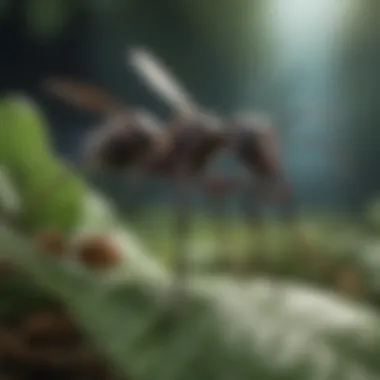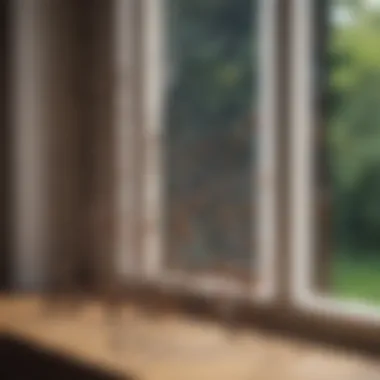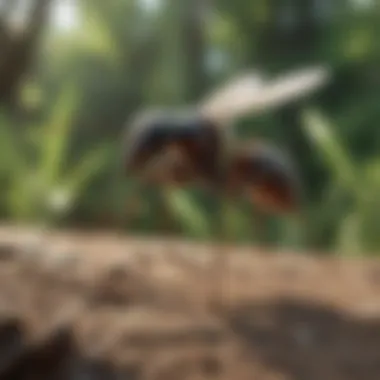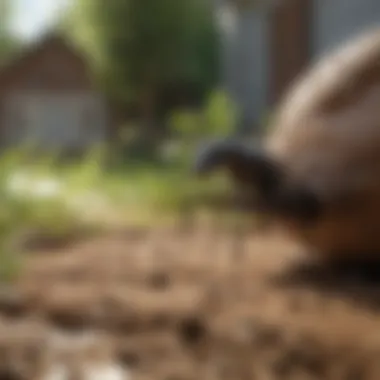Effective Strategies to Eliminate Flying Ants


Intro
Flying ants can pose a significant nuisance in residential settings, particularly during certain seasons. Understanding their habits and lifecycle is crucial for effective pest management. This article aims to provide homeowners with effective strategies to eliminate these insects from their homes. By learning about what attracts flying ants and how to prevent infestations, you can keep your living space comfortable.
The presence of flying ants often indicates a bigger problem; they may suggest an ant colony nearby. Therefore, it is vital to act promptly and efficiently to address the issue before it escalates. This guide encompasses various extermination methods and preventative tactics to ensure your home remains pest-free.
Key points to be covered include:
- Identification of flying ant species.
- Behavioral patterns and lifecycle.
- Effective prevention techniques.
- DIY extermination approaches.
- Professional solutions when DIY fails.
Let’s dive deeper into how to manage and eliminate flying ants effectively.
Understanding Flying Ants
Understanding the habits and life cycles of flying ants is essential for effective management. Knowledge in this area allows homeowners to identify the problem early and take appropriate action. Each aspect of their behavior provides insights into how to prevent and eliminate infestations. Grasping the nuances of flying ants can lead to better home maintenance choices and lower the chances of recurring issues.
Habitat and Behavior
Preferred environments
Flying ants favor warm, moist environments often found in urban areas. These conditions allow for the establishment of colonies. Densely wooded areas, gardens, or places with ample vegetation often serve as breeding grounds. Recognition of these preferred environments helps in anticipating where flying ants may thrive. Knowing these factors can influence homeowners to implement measures early to avoid severe infestations.
Activity patterns
The activity of flying ants typically peaks during specific periods, mainly in late spring and summer. They often become more visible during humid conditions when they swarm in search of mates. Understanding these patterns allows homeowners to adjust their preventive measures accordingly. For instance, monitoring areas where flying ants are commonly seen during peak times can help catch an infestation early.
Social structure
Flying ants, like many insects, exhibit a social structure that includes queens, workers, and males. The queen plays a pivotal role in establishing new colonies, while workers look after the larvae and maintain the nest. Recognizing this structure is crucial in understanding how infestations can grow rapidly. Effective strategies must consider the presence of these different castes, as they contribute to the overall population and reproduction rates.
Life Cycle of Flying Ants
Understanding the life cycle of flying ants is vital. Each stage impacts how infestations develop and what methods are most effective for elimination.
Eggs and larvae
Eggs are typically laid in warm weather. The larvae hatch from these eggs and are cared for by worker ants. This stage is crucial because it determines the success of the colony. Recognizing signs of eggs or larvae can help in taking preventive actions before an infestation escalates.
Development stages
Flying ants go through several development stages. Each stage from egg to adult presents opportunities for intervention. The duration of these stages can vary based on environmental conditions. Awareness of these stages is beneficial for planning effective extermination strategies and understanding how quickly a colony can regrow if not properly managed.
Reproductive phase
During the reproductive phase, flying ants leave the colony to mate and form new colonies. This phase usually occurs once a year and is marked by serious swarming behavior. The timing of this phase is important for homeowners to know. By acting during this period, they can take specific steps to disrupt the breeding cycle and limit future infestations.
"Understanding flying ants' behaviors, habitats, and life cycles aids in tailored strategies for prevention and eradication."
Effective strategies for eliminating flying ants rely heavily on the insights gained from understanding their existence and development. Each section discussed above contributes key information that improves the chances of maintaining a pest-free home.
Identifying Flying Ant Infestations
Identifying a flying ant infestation is crucial for maintaining a pest-free home. Recognizing these pests early can help avoid more extensive damage and discomfort later. Awareness of their distinctive signs and habits allows homeowners to act swiftly.
Proactive identification is not just about spotting an ant. It involves understanding their behavior and differentiating them from similar insects, particularly termites, which may lead to a misdiagnosis of the issue. This section will break down the identification process, focusing on how to distinguish flying ants from termites, signs of infestations, and their implications for home management.
Distinguishing Flying Ants from Termites


Physical characteristics
Flying ants and termites may appear similar at a glance, but several physical characteristics set them apart. Flying ants generally have a narrow waist and elongated antennae, while termites tend to have a thicker waist and straight antennae.
Knowing these differences is beneficial. This identification can prevent misdiagnosis of an infestation that could lead to improper treatment.
The unique feature of flying ants’ wings is also important. Ants have two pairs of wings, with the front pair larger than the back. Termites, on the other hand, have equal-sized wings. This aspect allows homeowners to confirm their suspicions about the type of pest they are dealing with. Understanding these characteristics helps in quickly determining the nature of the problem and choosing the appropriate course of action.
Behavioral differences
Behavioral differences also play a significant role in distinguishing flying ants from termites. Flying ants are often seen hovering around light sources, especially during warm evenings. Termites, by contrast, are more reclusive and prefer dark, damp areas.
A key characteristic of flying ants is their swarming behavior during mating season. This sudden appearance can catch homeowners off guard. Recognizing this pattern is a beneficial skill, as it can inform when an infestation may occur and encourage preventive measures.
The unique behavior of swarming may lead homeowners to unwittingly ignore other, less obvious signs of termite activity. Being aware of these differences enhances the ability to respond effectively and prioritize the correct pest management strategies.
Signs of an Infestation
Recognizing the signs of a flying ant infestation can be critical in preventing further problems in the home. The presence of flying ants does not always indicate a major infestation, but association with specific signs can indicate a growing concern.
Visual sightings
The simplest and often most immediate indicator of a flying ant infestation is visual sightings of the insects themselves. Homeowners must be vigilant for any sudden increases in ant activity.
This is a notable characteristic of visual sightings. Spotting a few flying ants may not mean a severe infestation, but it does warrant caution. Immediate observation encourages a timely response. It’s essential to consider the context of these sightings.
Seeing ants in unexpected places, like inside living areas or near windows, can be an alarming signal to take action. Monitoring such occurrences fosters a proactive approach to pest management.
Damage indicators
Another sign to look for includes potential damage caused by the ants. While flying ants do not cause structural damage, they are often associated with wood-destroying insects. Observing any signs of wood damage may indicate more severe issues related to infestations.
It’s effective to examine wooden structures and furniture for small holes or frass, which is the debris left by wood-destroying pests. Recognizing this damage can promote an urgent assessment of pest control methods. Homeowners benefit by identifying these indicators early, preventing further deterioration and associated costs.
Ant trails
Ant trails are often one of the most telling signs of an infestation. Flying ants leave pheromone trails that lead back to their nests. This behavior provides a unique opportunity to track the problem to its source.
Following these trails can lead to the identification of entry points into the home. A keen observation of this characteristic can lead to effective preventive measures.
Though these trails might be less visible during periods of swarming, they often indicate where the nest is located. Understanding the significance of these trails allows homeowners to take targeted actions for both extermination and future prevention efforts.
Effective identification of flying ant infestations is the first step toward comprehensive pest management. The ability to recognize signs early can significantly impact the effectiveness of control measures.
Prevention Techniques
Preventing flying ant infestations is key to maintaining a comfortable home. Effective prevention strategies can reduce the likelihood of an infestation and minimize future pest problems. By creating an inhospitable environment for these pests, homeowners can save time and money associated with extermination efforts. Furthermore, implementing preventive measures strengthens overall home hygiene. This proactive approach not only helps in keeping flying ants at bay but also contributes to a safer living space overall.
Home Maintenance Practices
Sealing entry points
Sealing entry points is about identifying and blocking potential areas where flying ants can enter your home. They can find their way through the tiniest gaps, whether in windows, doors, or even foundation cracks. By properly sealing these areas, you reduce the chances of an infestation occurring. This method is beneficial because it stops pests before they can cause any trouble. Using caulk, weather stripping, or mesh screens are common ways to enhance barriers against these insects. The limitation of this strategy may involve initial inspection efforts, but the ongoing benefits greatly outweigh these disadvantages.
Proper waste management
Proper waste management is crucial for discouraging flying ants. Ants are attracted to food sources, especially sweet and protein-rich items. Keeping trash bins tightly sealed and regularly disposing of waste can mitigate this attraction. This strategy is popular because it not only targets ants but also other pests that may sneak in. Ensuring proper storage of food items in airtight containers enhances this effort by minimizing odors. While this is an effective choice, it requires consistent effort and diligence which some may find challenging in busy households.
Regular inspections


Regular inspections involve routinely checking for signs of ants and other pests in the home. This could mean looking for visible ant trails or nest establishment in hidden corners. Early detection allows for prompt action and prevents large-scale infestations. Regular checks are beneficial as they build a habit of vigilance within the household. The unique characteristic of this practice is that it empowers residents by increasing awareness of their environment. Although it demands time and effort, the long-term benefits make regular inspections worthwhile.
Environmental Controls
Landscaping considerations
Landscaping considerations play an important role in pest prevention, including flying ants. The choice of plants and their placement can greatly influence pest activity. Keeping plants trimmed and preventing excess mulch can minimize sheltered areas that attract flying ants. This approach is beneficial because it tackles the problem outdoors before it can affect the inside of your home. The unique feature of landscaping is its dual benefits of enhancing home aesthetics and pest control. While adjusting your landscape can involve some effort and planning, the rewards include a more visually appealing environment and a reduction in pest attractants.
Moisture control
Moisture control affects ant populations significantly. Flying ants thrive in humid environments, thus ensuring adequate drainage and ventilation is essential. Regularly checking for leaks and managing indoor humidity levels can prevent conditions that favor ants and similar insects. This method is beneficial, as it not only targets flying ants but also contributes to overall home maintenance. The unique aspect of moisture management is its positive impact on indoor air quality and structural integrity. The slight downside may include ongoing adjustments but the health benefits and pest prevention make it worthwhile.
Outdoor lighting adjustments
Outdoor lighting adjustments can also deter flying ants. Many species are attracted to bright lights at night. Utilizing yellow-tinted bulbs or strategically placing lights away from entrances can make your home less inviting to flying ants. This method is popular as it is simple and cost-effective. The unique feature here is that it aligns pest prevention with energy-efficient outdoor lighting options. While changing bulbs may seem trivial, the collective effect can lead to a measurable decrease in flying ant activity around your home.
DIY Extermination Methods
DIY extermination methods offer a valuable approach for homeowners seeking to manage flying ant issues effectively. Using these methods allows individuals to tackle infestations quickly, often with readily available materials. The importance of such strategies lies in their cost-effectiveness and accessibility. Homeowners can implement solutions without depending solely on professional pest control services.
Furthermore, DIY methods can be a proactive step in preventing future infestations, which enhances the overall home environment.
Natural Remedies
Vinegar solutions
Vinegar solutions are frequently recommended due to their effectiveness and ease of use. The acetic acid in vinegar acts as a repellent, disrupting the pheromone trails that ants follow. This characteristic makes vinegar a beneficial choice for this article. Its non-toxic nature and general safety around pets and children add to its appeal. One unique feature of vinegar solutions is their ability to blend with other natural ingredients, enhancing their efficacy.
However, while vinegar is helpful in repelling flying ants, it may not eliminate an entire population entirely.
Boric acid traps
Boric acid traps serve as an efficient method for controlling flying ant populations. Boric acid is a low-toxicity insecticide that works by disrupting the digestive system of ants when ingested. This differentiates it as a popular choice among homeowners looking for effective extermination methods.
A unique feature of boric acid traps lies in their slow-acting nature, which allows ants to carry the bait back to their colony. This can ultimately lead to more substantial reductions in the flying ant population. Despite its advantages, caution is needed when using boric acid, especially around children and pets, as ingestion can be harmful.
Essential oils
Essential oils are another natural remedy that can be useful in deterring flying ants. Oils such as peppermint or tea tree oil have strong scents that ants find unpleasant. Additionally, using essential oils offers a non-toxic alternative to conventional insecticides, satisfying home environments that prioritize safety. They are also versatile, as they can be applied in various ways, such as in diffusers or diluted sprays.
However, the effectiveness of essential oils may vary, and they often provide only temporary relief rather than lasting extermination.
Chemical Solutions
Commercial insecticides
Commercial insecticides offer potent solutions for managing severe flying ant infestations. These products contain specialized formulas designed to effectively target various ant species. Their strengths include rapid action and widespread availability at home improvement stores. This connection to strength explains why many homeowners consider them as the leading choice for extermination.
One unique feature of these insecticides is their formulation, which may include pesticides specifically approved for indoor use. However, it is crucial to consider potential side effects. Inappropriate use could lead to residue issues and may affect indoor air quality, stressing the importance of following safety guidelines during application.
Safety precautions
Safety precautions are paramount when using chemical solutions. The primary emphasis here is ensuring the safety of household members and pets during and after application. Reading labels and adhering to recommended usage is essential. This characteristic makes safety precautions a critical part of attaining effectiveness in pest control.
Being informed about the toxicity levels of specific chemical solutions helps mitigate health risks involved in their use.
Application tips


Application tips enhance the effectiveness of chemical solutions while ensuring safety. Proper application techniques can maximize contact with flying ants and reduce wastage of the product. Key characteristics include timing the application when ants are most active and targeting areas where they are spotted frequently.
Different products may also require specific application methods, such as spraying or dusting. Understanding these details allows homeowners to utilize their chosen insecticides benefit fully, improving the chances of successful eradication.
Professional Pest Control Options
In dealing with flying ants, professional pest control options present a viable solution for homeowners. They offer specialized expertise that can be vital in managing infestations effectively. Understanding the nuances of when to seek expert help and how to evaluate pest control services is essential for ensuring the longevity of a pest-free environment.
When to Seek Professional Help
Recognizing the right time to call in the experts can save homeowners from worsening situations and added frustrations.
Extent of the infestation
The extent of an infestation is a critical factor in deciding whether to engage a professional pest control service. If flying ants have invaded multiple areas of your home or are noticeable in significant numbers, this signals a deeper problem. Homeowners often benefit from professional intervention in these cases. A key characteristic of extensive infestations is the potential for structural damage, which can be costly if not addressed promptly. By understanding the unique nature of the infestation, professionals can deploy more comprehensive methods, ensuring thorough eradication.
Health considerations
Health considerations often factor into the decision to seek professional pest control. Flying ants can potentially affect indoor air quality and lead to allergic reactions in sensitive individuals. A key characteristic of health risks associated with pests involves the potential transmission of diseases. This aspect makes it crucial for individuals with health issues to consider professional services. The unique feature of addressing health considerations through expert intervention is that they can also offer insights into safe, effective treatments that minimize risks.
Effectiveness of DIY methods
In many cases, homeowners initially try DIY methods to eliminate flying ants. However, the effectiveness of these methods can vary significantly based on the situation. A key characteristic of DIY techniques is their accessibility and low cost. They provide a temporary fix but might not ensure complete eradication of the problem. This can lead homeowners to eventually rely on professionals. The unique factor here is the understanding of when DIY becomes less effective, thus requiring a more powerful solution that only an expert may provide.
Evaluating Pest Control Services
Once the decision has been made to seek professional help, evaluating pest control services becomes critical.
Licensing and certifications
Licensing and certifications are fundamental when choosing a pest control service. These credentials indicate that a company is trained and adheres to regulations. A key characteristic is that licensed professionals follow safety protocols that protect both residents and the environment. The unique feature is that not all companies have these credentials, making it essential to verify them before hiring a service. This assessment can prevent mistakes and ensure the selection of a reputable provider.
Methods and products used
Understanding the methods and products used by pest control services is another vital consideration. Many companies employ different extermination techniques, some of which may be more effective than others. A key aspect of methods is adhering to environmentally-friendly practices while ensuring effectiveness. This can appeal to homeowners who are conscious of both results and their ecological impact. The unique feature to note is that some pest control services offer a tailored approach, customizing their methods based on specific home environments and infestation levels.
Costs and warranties
Finally, evaluating costs and warranties can influence the decision-making process. Understanding the price range of services helps homeowners budget effectively and choose a reasonable option. A key characteristic of warranties is that they often provide reassurance about the effectiveness of the service. If pests return, a warranty means that the service will re-treat the problem without further charges. The unique factor regarding costs is that they can vary greatly based on location, service types, and contractual terms.
Ensuring that you understand all aspects of pest control services can lead to better decisions, ultimately resulting in a safer and more comfortable living environment.
Long-term Management Strategies
Effective long-term management strategies are essential for homeowners dealing with flying ants. These strategies not only address immediate concerns but also prevent future infestations. Maintaining a pest-free living environment requires ongoing effort and awareness. By understanding the dynamics of flying ants, one can implement robust management techniques that ensure sustainability in pest control.
Monitoring and Maintenance
Regular checks post-extermination
Redundancy in checks after extermination is pivotal. Regular checks post-extermination can significantly reduce the chances of a reinfestation. This approach allows homeowners to identify any remaining issues quickly. It is beneficial because continuous monitoring keeps infestations in check before they escalate. The key characteristic here is vigilance, and it is popular among those who have faced larger infestations previously. A unique feature of this method is its proactive nature in pest management. The advantage of maintaining regular checks is that it supports early detection, leading to minimal disruption. However, it requires time and commitment from the homeowner.
Adjusting strategies based on seasons
The changing seasons greatly influence the behavior of flying ants. Therefore, adjusting strategies based on seasons becomes important in pest management plans. This method involves tailoring your defense mechanisms to seasonal changes. For instance, during warmer months, flying ant activity may increase, necessitating a more aggressive approach. The key characteristic of this strategy is its adaptability, making it a beneficial choice for year-round management. A unique feature is that it allows for fine-tuning based on real-time conditions, ensuring effectiveness in different environmental contexts. The advantage of this method is that it aligns pest control efforts with the natural life cycles of the ants. However, a disadvantage could be the need for constant reevaluation of strategies as conditions evolve.
Educating Household Members
Signs to look for
Recognizing the signs of flying ant activity is crucial. Knowing the signs to look for can empower household members to act swiftly. This knowledge contributes to a collective effort in pest management. The key characteristic of this awareness is its simplicity; it equips everyone with the ability to identify potential infestations early. The unique feature is that it creates a unified response within the household. The advantage of being educated on signs is that it minimizes confusion among members, promoting a coordinated approach to management. On the downside, it requires a commitment to update knowledge regularly, as pest behavior may change over time due to environmental factors.
Preventative measures everyone can take
Every household member can play a role in preventing flying ant infestations. The importance of preventative measures everyone can take cannot be overstated. This strategy enhances the effectiveness of long-term management. The key characteristic of preventive measures is their accessibility; anyone can implement these simple steps. A unique feature is that they can be incorporated into daily routines without much effort. The advantage of having everyone involved is that it fosters a sense of responsibility and collective ownership over household cleanliness and maintenance. However, a challenge could arise if not everyone is willing to participate, thus creating gaps in the preventive efforts.















